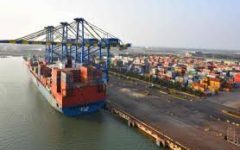
CK Govil, President, ACAAI talks about the theme of the upcoming convention, ‘Wings of Innovation: Charting New Paths in Logistics’ and shares that the theme emphasises the dynamic and transformative role innovation plays in the logistics industry. The logistics sector is undergoing a digital revolution, driven by technologies like AI, IoT, blockchain, and big data These innovations help optimize supply chains, improve transparency, and boost efficiency. For example:
– AI and predictive analytics enable companies to forecast demand, streamline routing, and reduce delivery times.
– IoT-enabled sensors provide real-time tracking of cargo, improving visibility across the supply chain.
– Blockchain technology ensures secure and transparent transactions, particularly in verifying shipment records, reducing fraud, and building trust between stakeholders. Environmental sustainability is becoming a major focus in logistics, and innovation is at the heart of this transformation. Companies are now investing in:
– Alternative fuels like electric and hydrogen-powered vehicles for transportation to reduce carbon emissions.
– Efficient route optimization software that minimizes fuel consumption and reduces unnecessary transport miles.
– Circular logistics that focuses on waste reduction and recycling within the supply chain.
The integration of autonomous vehicles and drones is poised to revolutionize last-mile delivery:
– Drones are already being tested for quick, short-distance deliveries in congested urban areas and remote locations. This not only saves time but also reduces traffic and emissions.
– Self-driving trucks could reduce labor costs, improve safety, and ensure round-the-clock transportation without the limitations of human drivers.
The pandemic underscored the need for resilient supply chains. Innovation in logistics can help companies be better prepared for future disruptions:
– Cloud-based logistics platforms facilitate real-time coordination among multiple stakeholders.
– AI-driven contingency planning allows businesses to quickly adapt to disruptions, whether from global pandemics, geopolitical tensions, or natural disasters.
– Decentralized storage systems* (e.g., micro-warehousing) spread across regions help mitigate risks associated with a single-point failure.
Hyper-Connectivity and Real-Time Decision Making
Real-time communication and decision-making have become essential for modern logistics:
– Hyper-connected platforms allow instant data sharing between manufacturers, shippers, and customers, ensuring rapid responses to any issues along the supply chain.
– Predictive logistics software provides insights into potential bottlenecks, traffic, or weather disruptions, enabling preemptive rerouting or rescheduling to ensure timely deliveries.
Personalized and Customer-Centric Logistics
Innovation is also allowing the logistics industry to offer more personalized, customer-centric services:
– Customers today expect faster, more flexible, and more precise delivery options. Innovative solutions like same-day delivery or flexible time windows are now becoming standard.
– The use of AI-driven customer service tools can anticipate customer needs, handle queries, and provide real-time tracking updates.
Collaborative Networks and Shared Economies
Another innovative path logistics is taking is through the creation of collaborative networks:
– Shared logistics platforms allow companies to pool resources such as warehouses, fleets, and distribution centers, reducing costs and increasing operational efficiency.
– Logistics as a Service (LaaS) models are emerging, where companies can outsource their entire logistics operations to specialized providers who leverage technology and innovation for optimized services
Conclusion
Innovation is the “wing” that will propel the logistics industry forward, charting new paths in efficiency, sustainability, and resilience. As digital transformation, AI, and new technologies continue to evolve, they will reshape the future of logistics, offering better, faster, and more sustainable solutions to meet global demands. The ability to adapt and integrate these innovations will determine which companies thrive in this rapidly changing landscape.
 Cargo Breaking News
Cargo Breaking News


